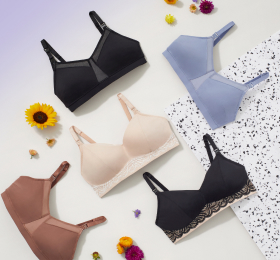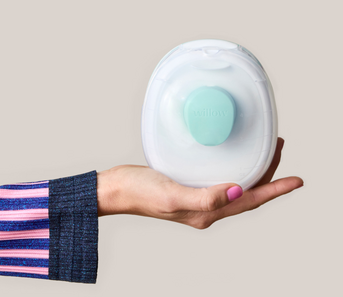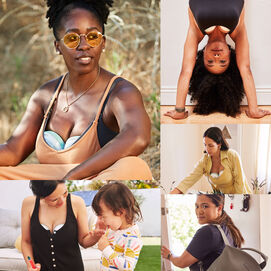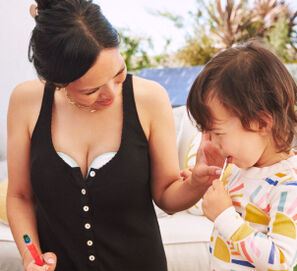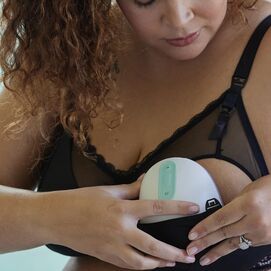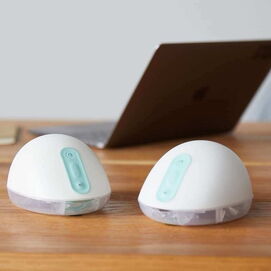Whether you’re starting to breastfeed for the first time or are a veteran in the department, it’s important to remember that there is no right or wrong when it comes to breastfeeding positions. Each mama and baby have their own methods that work best for them, and sometimes it can take time to find that sweet spot. The most important part of the breastfeeding checklist is that both you and your baby are comfortable.
If you haven’t found a breastfeeding position that works best for you, have no fear. In this blog we cover the most popular and efficient breastfeeding position for you and your baby. You never know, you may find your next favorite technique!
Willow Daily Pumping Bra
Willow Daily Pumping Bra
You’ll never want to take off the aptly-named Daily Pumping Bra. Custom-made for Willow by The Dairy Fairy, it’s comfy, supportive, and no-fuss—what every breast pump bra should be.
What Position is Best for Breastfeeding?
There are no universal breastfeeding positions that are guaranteed to work for every mom. Like we’ve said, every mama and baby duo is unique, so much of it depends on what works best for you! With that being said, there are some things to keep in mind when finding an effective and comfortable position:
- Make sure your baby has a good latch
- Make your space comfy with pillows, blankets, and drinks or snacks.
- Go to the bathroom beforehand
- Position your baby so that their head is facing your breast and they do not need to strain
- Support your breast so that your baby’s chin first touches your breast, then their nose
A bad or inefficient breastfeeding position can occur when you or the baby is awkwardly positioned. In other words, it’s important to find a position where your baby’s body is aligned so they can breathe and feed properly. A bad feeding position can lead to an improper latch. Take the time to make sure both you and your baby are comfortable for a positive breastfeeding experience.
8 Breastfeeding Positions
Like we’ve said, there is no blueprint breastfeeding position for all mamas. Below are eight of the most common breastfeeding positions that mamas use and our lactation consultants recommend. Try them out, and see what works for you!
-
Cradle Hold
The cradle hold is a popular breastfeeding position because it is comfortable for both a mama and baby. It can also help guide a baby’s mouth towards the nipple, which is great for improving a latch.
How to: For this position, your baby will be laying on their side depending on what breast they are feeding from. If your baby is feeding from your right breast, cradle them with your right arm. Your baby’s head can rest on your right arm while it lays on its left side, facing the nipple. In order to guide the nipple to your baby’s mouth, you can use your left arm to support your breast.
Be sure to use pillows and sit in a comfortable location so that your arms and back are supported. You may also add pillows underneath your baby to bring them up to the height of your breast. Reverse the process for the left side.
-
Crossover
The crossover, or cross-cradle, is great for the early-stages of breastfeeding because it allows you to have more control over your baby’s latch.
How to: For this position, you’ll want to be sitting up straight. Position your baby tummy to tummy, lying across your body, similar to the cradle position. In this position, you’ll want to hold your baby with the arm opposite the breast the baby is feeding from (i.e. left arm for right breast, right arm for left breast). Hold your baby’s head with your available hand. With your other arm, hold your baby in a cradle position. It’s important to not lean or hunch over your baby in this position, but rather guide them to your breast.
-
Football
The football hold is great for mamas who are recovering from a C-section, have large breasts, have a strong milk let-down, or are simply most comfortable breastfeeding in this position.
How to: Hold your baby against your side, with your arm bent in a cradle position. With the same arm, you can support your baby’s head with your hand. Guide your baby’s head to your breast with the cradling arm. You may put some blankets or pillows on your lap to rest your arm for extra comfort.
-
Laid-Back
While the laid-back breastfeeding position can be beneficial for mamas recovering from C-sections, it can also be one of the most comfortable positions if executed properly. This position may also be a great opportunity to get some of that cherished skin to skin contact with your little one.
How to: In this position, the baby can approach the breast and nipple from any direction. You may place your baby on your stomach so that you can make eye-contact with them and support them. You can also position your baby across your shoulder and breast so that they’re body passes by your head. This position works best when you avoid pressing on the back of the baby's head. Pressing on the back of the head can cause the baby to push into your hand and away from your breast, press instead on their lower back to hold them in place if necessary.
Your level of recline is completely up to you in this position. Just make sure that your head and back are supported, and that you are comfortable!
-
Side-lying
The side-lying position is another comfortable position for resting while you breastfeed your baby. This position may take some practice, but can be an incredibly bonding experience for the two of you.
How to: Simply lie on your side and position your baby towards your breast. With your free hand, guide your breast towards your baby’s mouth. After they latch on, you can use your hand to support their back and bring them closer to you as they breastfeed.
-
Koala Hold
The koala hold is an upright breastfeeding position, and may be useful for the middle to late stages of breastfeeding.
How to: Position the baby so they are sitting upright, straddling your knee, and facing your breasts. Scootch your baby forward so they are sitting tummy to tummy with you. It’s important to ensure that your baby’s head and neck are supported in this position. Use your open hands to support their head, while also guiding them towards the nipple.
-
Dangle Feeding
Dangle feeding can be useful for mamas struggling with blocked milk ducts. Because you are dangling your breasts in this position, gravity may help to stimulate milk flow and unclog milk ducts.
How to: Place your baby flat on your lap and dangle your breast over their mouth for them to nurse. You may also experiment with placing your baby flat on the ground or on the couch. This is likely not the most comfortable position for mamas, but it can help with releasing some of your breastmilk.
-
Using a Sling
If you are on the go, breastfeeding with a sling can be helpful! Many slings allow mamas to adjust their baby into a suitable breastfeeding position while going about their daily routine. It can be tricky to perfect the sling technique, and you may need to try out a few positions or products to find the one that works best for you and your baby. This is a great position when you are out in public, the sling covers your breast and you can move around as well.
How to: Adjust your sling so that your baby’s mouth is close to your breast. Make sure your baby is laying towards the side that they are feeding on. Once they start feeding, your baby should be able to cup both sides of your breast with their hands. Remember that a sling is meant to make the process more hands free for you, if the sling is not fully supporting your baby, you may need to make some adjustments.
Finding the right breastfeeding position can be tricky, but finding one that works for you makes the process worth it! Have more questions about breastfeeding, pumping, and beyond? Visit the Willow blog to get all of your answers covered.
Get pumping support with Simplifed
Get pumping support with Simplifed
Get access to free virtual feeding support from the lactation consultants at Simplifed. They can help you navigate supply issues, introduce a bottle, and more, and are trained on Willow pumps.
This article was written in partnership with our International Board Certified Lactation Consultant, Wendy Wright, who loves working side by side with moms and babies to find that secret sauce! She’s also a mother of two and the Mom Experience Lead at Willow Pump.


